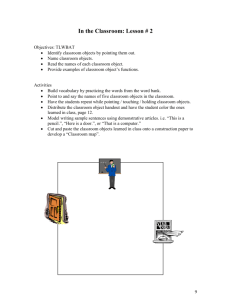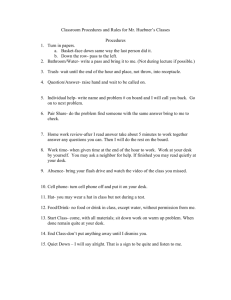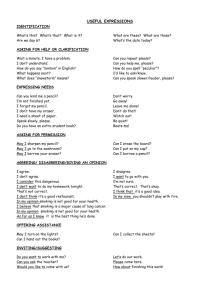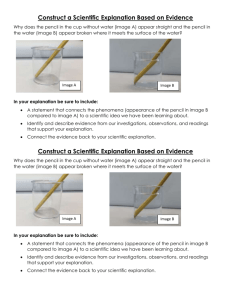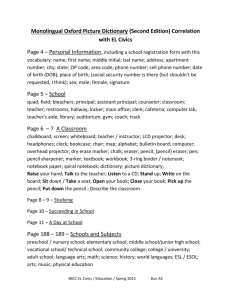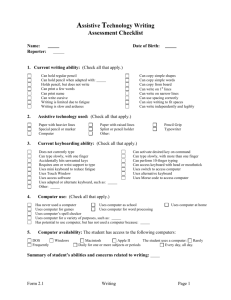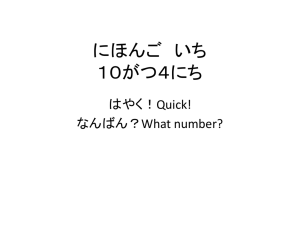Unscramble Correct Order of Instructions Lesson Plan
advertisement
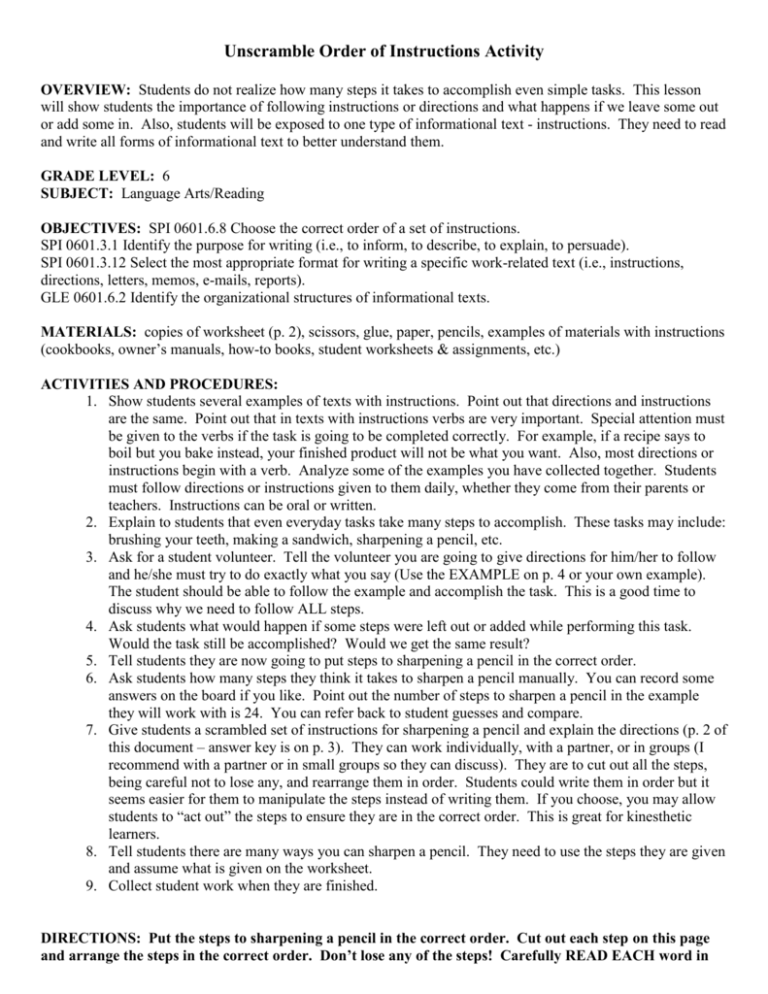
Unscramble Order of Instructions Activity OVERVIEW: Students do not realize how many steps it takes to accomplish even simple tasks. This lesson will show students the importance of following instructions or directions and what happens if we leave some out or add some in. Also, students will be exposed to one type of informational text - instructions. They need to read and write all forms of informational text to better understand them. GRADE LEVEL: 6 SUBJECT: Language Arts/Reading OBJECTIVES: SPI 0601.6.8 Choose the correct order of a set of instructions. SPI 0601.3.1 Identify the purpose for writing (i.e., to inform, to describe, to explain, to persuade). SPI 0601.3.12 Select the most appropriate format for writing a specific work-related text (i.e., instructions, directions, letters, memos, e-mails, reports). GLE 0601.6.2 Identify the organizational structures of informational texts. MATERIALS: copies of worksheet (p. 2), scissors, glue, paper, pencils, examples of materials with instructions (cookbooks, owner’s manuals, how-to books, student worksheets & assignments, etc.) ACTIVITIES AND PROCEDURES: 1. Show students several examples of texts with instructions. Point out that directions and instructions are the same. Point out that in texts with instructions verbs are very important. Special attention must be given to the verbs if the task is going to be completed correctly. For example, if a recipe says to boil but you bake instead, your finished product will not be what you want. Also, most directions or instructions begin with a verb. Analyze some of the examples you have collected together. Students must follow directions or instructions given to them daily, whether they come from their parents or teachers. Instructions can be oral or written. 2. Explain to students that even everyday tasks take many steps to accomplish. These tasks may include: brushing your teeth, making a sandwich, sharpening a pencil, etc. 3. Ask for a student volunteer. Tell the volunteer you are going to give directions for him/her to follow and he/she must try to do exactly what you say (Use the EXAMPLE on p. 4 or your own example). The student should be able to follow the example and accomplish the task. This is a good time to discuss why we need to follow ALL steps. 4. Ask students what would happen if some steps were left out or added while performing this task. Would the task still be accomplished? Would we get the same result? 5. Tell students they are now going to put steps to sharpening a pencil in the correct order. 6. Ask students how many steps they think it takes to sharpen a pencil manually. You can record some answers on the board if you like. Point out the number of steps to sharpen a pencil in the example they will work with is 24. You can refer back to student guesses and compare. 7. Give students a scrambled set of instructions for sharpening a pencil and explain the directions (p. 2 of this document – answer key is on p. 3). They can work individually, with a partner, or in groups (I recommend with a partner or in small groups so they can discuss). They are to cut out all the steps, being careful not to lose any, and rearrange them in order. Students could write them in order but it seems easier for them to manipulate the steps instead of writing them. If you choose, you may allow students to “act out” the steps to ensure they are in the correct order. This is great for kinesthetic learners. 8. Tell students there are many ways you can sharpen a pencil. They need to use the steps they are given and assume what is given on the worksheet. 9. Collect student work when they are finished. DIRECTIONS: Put the steps to sharpening a pencil in the correct order. Cut out each step on this page and arrange the steps in the correct order. Don’t lose any of the steps! Carefully READ EACH word in the steps. You may think some steps are listed twice. There are slight differences in every step, but not one step is listed exactly the same way twice. Do NOT glue the steps until you have read through them all in the order you have them and you are certain they are in the correct order. Glue the steps on another sheet of paper. Make sure your name(s) is on that paper and turn it in. The materials you have to sharpen your pencil are: chair, desk, pencil, and pencil sharpener (manual). ASSUMPTIONS: You are sitting at your desk at the beginning and at the end of this task. The pencil is on your desk at the beginning of this task and it has never been sharpened. Push chair under desk. Pick up pencil. Raise your hand. Sit down. Walk back to desk. Turn handle of pencil sharpener clockwise. Put pencil in sharpener and hold in place. Pull pencil out of sharpener again. Begin writing with pencil. Pull chair out. Push chair back. Teacher calls on you. Ask permission to sharpen your pencil. Put pencil back in sharpener and hold in place. Stand up. Walk to pencil sharpener. Stop turning handle again. Teacher gives you permission to sharpen your pencil. Pull chair up. Check to see if pencil is sharpened again. (assume it is) Turn handle of pencil sharpener clockwise again. Check to see if pencil is sharpened. (assume it is not) ANSWER KEY Pull pencil out of sharpener. Stop turning handle. 1. Raise your hand. 2. Teacher calls on you. 3. Ask permission to sharpen your pencil. 4. Teacher gives you permission to sharpen your pencil. 5. Pick up pencil.* 6. Push chair back. 7. Stand up. 8. Push chair back under desk. 9. Walk to pencil sharpener. 10. Put pencil in sharpener and hold in place. 11. Turn handle of pencil sharpener clockwise. 12. Stop turning handle. 13. Pull pencil out of sharpener. 14. Check to see if pencil is sharpened. (assume it is not) 15. Put pencil back in sharpener and hold in place. 16. Turn handle of pencil sharpener clockwise again. 17. Stop turning handle again. 18. Pull pencil out of sharpener again. 19. Check to see if pencil is sharpened. (assume it is) 20. Walk back to desk. 21. Pull chair out. 22. Sit down. 23. Pull chair up. 24. Begin writing with pencil. *The only step that could be in a different order is picking up pencil (#5). This could be done after getting up from desk. So, it could possibly be #8. The order would then be: 5. Push chair back. 6. Stand up. 7. Push chair back under desk. 8. Pick up pencil. EXAMPLE – Choose a student volunteer who will try to follow these directions as you read them. You may want to skip a step and see how the student reacts or what will happen and point out how every step is necessary to complete the task correctly. (Just for fun: You could ask your whole class to bring a bottle of water on the day you do this lesson and provide Kool-Aid packets for every student to use. It would definitely be a lesson they would remember!) How to Make Kool-Aid (single packet) (You may want to ask students to guess how many steps this will take to complete and write guesses on the board.) What you need (all materials should be on student’s desk before beginning): Bottle of water (never opened) Single Kool-Aid packet (any flavor) Scissors Procedures or Steps: 1. Pick up bottle of water with one hand and hold. 2. Turn bottle lid with other hand until lid is off bottle. 3. Set lid down on desk. 4. Set bottle of water down on desk. 5. Pick up scissors. 6. Pick up Kool-Aid packet. 7. Cut top of Kool-Aid packet with scissors. 8. Set scissors down on desk. 9. Pour contents of Kool-Aid packet in bottle of water. 10. Set Kool-Aid packet down. 11. Pick up bottle lid. 12. Pick up bottle of water. 13. Place lid on top of the bottle of water. 14. Turn lid until tightened. 15. Shake bottle of water until Kool-Aid is dissolved. 16. Take lid off bottle. 17. Enjoy your Kool-Aid!
